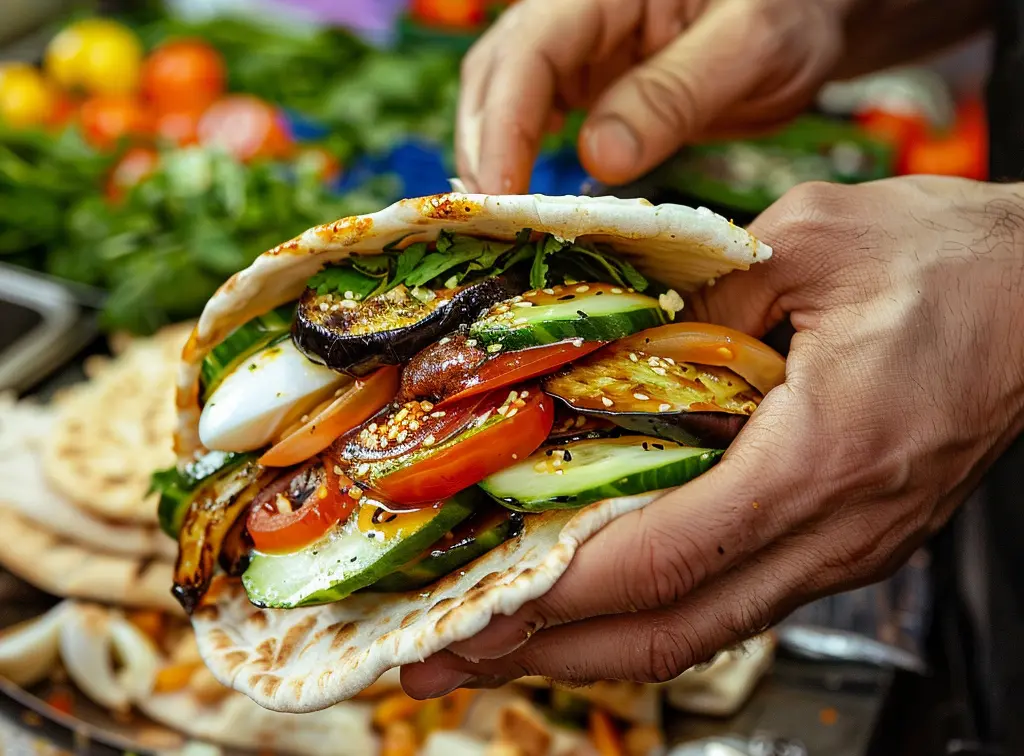
Israeli cuisine was shaped by Iraqi Jews, with dishes like sabich showcasing this fusion. Sabich, a beloved sandwich, reflects the blend of Iraqi and Israeli culinary traditions, preserving heritage while embracing innovation.
Israeli cuisine is a rich mosaic, drawing from diverse backgrounds. Among the many cultural influences, the Iraqi Jewish community has significantly impacted Israeli food. A mouth-watering testament to this is sabich, a sandwich that embodies the fusion of Iraqi and Israeli culinary traditions.
The mid-20th century was a pivotal era for the Iraqi Jewish community. Facing rampant anti-Semitism, many Iraqi Jews left their homeland and sought refuge in Israel, bringing their rich cultural heritage, including thier culinary traditions.
Between 1948 and 1951, approximately 120,000 Iraqi Jews moved to Israel during Operation Ezra and Nehemiah. They fled Iraq due to anti-Semitic laws, violent riots such as the Farhud of 1941, economic discrimination, and the influence of the Zionist movement.
Despite integration challenges, the Iraqi Jewish community maintained their traditions. Their cuisine became a cornerstone of their cultural identity, with dishes like sabich serving as delicious reminders of home. This preservation enriched Israeli cuisine and ensured future generations could savour their heritage.
The sabich sandwich originated with Sabih Tzvi Halabi, an Iraqi Jew who settled in Ramat Gan. Sabih brought a cherished tradition from Iraq—a Sabbath morning treat of fried eggplant, hard-boiled eggs, and other delicious ingredients. This dish evolved from a family recipe to a celebrated street food item in Israel.
Initially enjoyed as part of the Shabbat breakfast, sabich was a comforting, hearty meal designed to be simple yet satisfying.
Over time, sabich became a popular street food. Its portability and robust flavours made it an ideal grab-and-go option for busy city dwellers. This transformation showcases how culinary traditions adapt and thrive in new environments.
The beauty of sabich lies in its unique combination of ingredients that blend flavours and textures perfectly. Fried eggplant forms the base, while hard-boiled eggs add smoothness and protein.
The use of fried eggplant and hard-boiled eggs highlights Iraqi cuisine, while amba sauce and tahini showcase Middle Eastern flavours quintessentially Israeli. This combination honours tradition while embracing innovation.

For Iraqi Jews, sabich was more than just food; it was integral to their Sabbath morning meal. It allowed them to follow dietary restrictions without compromising on taste. This dish illustrates how culinary practices adapt to religious customs while preserving cultural heritage.
Sabich’s cultural significance extends beyond its ingredients and dietary customs. It has become part of the culinary scene in places like the Mediterranean island of Gozo, showcasing its widespread appeal.
Sabich and falafel are two iconic Middle Eastern street foods. While distinct, both share a common thread of being pita bread sandwiches with flavourful fillings.
Rooted in Iraqi Jewish tradition, sabich is a symphony of fried eggplant, hard-boiled eggs, tangy amba sauce, and creamy tahini, creating a culinary bridge between Iraq and Israel.
Falafel, made from ground chickpeas or fava beans and deep-fried, offers a crunchy contrast to the soft textures of sabich. Both dishes highlight the dynamic nature of Middle Eastern cuisine and the continual evolution of traditional recipes.
Sabich’s journey from humble street food to gourmet delight is a testament to its enduring popularity and versatility. Initially sold by street vendors, it has now found its way into upscale restaurants across Israel.
Early Beginnings: Sabich was initially a quick, satisfying meal for people on the go.
Modern Twist: Today, chefs infuse sabich with creative twists, elevating it to new culinary heights.
Tel Aviv is renowned for its vibrant food scene, making it a paradise for sabich enthusiasts. Some must-visit spots include:

Creating a classic sabich sandwich at home is simple. The key ingredient is the fried eggplant. Here’s how to make your own delicious sabich:
The influence of Iraqi-Jewish flavours continues to inspire culinary innovation in Israeli cuisine. Chefs are constantly pushing boundaries, creating new interpretations of traditional dishes that honour their rich heritage while appealing to modern tastes.
Chefs are experimenting with different ingredients and methods, combining them in ways that celebrate the complexity and richness of Middle Eastern cuisine. Future dishes may feature unexpected combinations like:
The culinary adventure in Israel offers a variety of fusion dishes waiting to be discovered. From amba-laced shawarma to za’atar-spiced pastries, the blend of Iraqi-Jewish traditions and contemporary Israeli flavours promises endless possibilities for chefs and food enthusiasts alike.

At Med.kitchen, our passion lies in crafting exceptional culinary experiences through our online platform. We specialise in sharing a wealth of knowledge via articles, recipes, courses, and online mentoring, aiming to inspire both novice and seasoned chefs alike. Our focus has shifted from private dining to being an online source of gastronomic inspiration, allowing you to explore and refine your culinary skills from the comfort of your home..